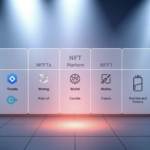Now Reading: Learn Blockchain Technology Explained for Business Owners
- 01
Learn Blockchain Technology Explained for Business Owners
Learn Blockchain Technology Explained for Business Owners

This Ultimate Guide) introduces how a shared, tamper-resistant ledger can cut friction across multiparty processes.
The core attributes — consensus, replication, immutability, and security — create a single trusted record that speeds settlement and eases audits.
Nearly 4 in 10 U.S. workers report widespread use today, and most expect adoption to grow soon, according to a February 2023 EY survey. That momentum shows practical benefits across supply chains, finance, healthcare, retail authenticity, and more.
Read on to get concise insights on when permissioned ledgers suit enterprise needs, how shared records reduce reconciliation, and examples like IBM Food Trust and trade finance pilots that deliver real outcomes.
What Business Owners Need to Know Right Now
Start with the practical wins: reduce delays and disputes by letting all approved participants see the same validated record at the same time. Permissioned networks let trusted users access identical data, which cuts duplicate entries and speeds reconciliation.
Real-time processing runs 24/7 and keeps transactions moving outside bank cutoffs. That improves cash flow and shortens settlement cycles.
Immutability raises confidence: records can’t be silently altered, so audits and compliance are easier and disputes fall. Identity and access controls limit visibility to authorized users, protecting sensitive data in shared workflows.

- Target multiparty processes with recurring reconciliation pain and manual handoffs.
- Identify quick wins where automated rules standardize routine steps among parties.
- Consider customer-facing uses—warranties or authenticity—where transparency builds trust.
- Plan change management and set measurable goals for dispute reduction and cycle-time gains.
Blockchain Fundamentals for Business
Think of a ledger that only updates after group validation and then replicates to all members. This simple pattern drives a reliable shared record across a controlled network.
From ledgers to networks: key terms explained
Blocks are approved records. Nodes are the participants running software. Consensus is the agreement process that allows a block to join the ledger.
Channels create private sub-networks so selected parties see only relevant data. Once a block is validated, replication distributes identical copies to every node in that channel, creating one consistent view.

Public vs. permissioned and when each fits
Public networks are open and decentralized. Permissioned models restrict who can write and who has read access, which suits companies that face regulatory or confidentiality needs.
- Permissioned systems match enterprise identity and performance SLAs.
- Membership services control who can endorse transactions and which services run on the channel.
- Typical applications include provenance tracking, shared document workflows, and automated compliance checks.
How Blockchain Works under the Hood
Each new entry locks to the prior one using hashes, making alterations easy to spot and hard to hide. This cryptographic chaining plus coordinated validation creates a tamper-resistant flow of data that teams can trust.

Consensus, replication, immutability, security
Consensus validates transactions before they become part of the ledger. Nodes agree on the outcome so only legitimate operations are appended.
Replication spreads identical copies to authorized peers, giving resilience and a single source of truth. Immutability means prior entries stay as-is; updates are new entries that keep the trail intact.
Security uses permissioned controls so organizations decide who can propose, endorse, or read blocks.
Sequential blocks, hash codes, and digital tokens
Sequential hashing links each record to its predecessor with a hash code. Any change breaks the chain and is immediately detectable.
Digital tokens can represent assets or rights and enable programmable transfers without exposing core data publicly.
Smart contracts and automated business rules
Smart contracts encode rules that run automatically when conditions match. They speed routine processes and reduce disputes while integrating with existing systems via APIs.
Why It Matters: Core Benefits to Your Organization
When many parties must agree, a single validated record creates faster, clearer workflows. This change reduces manual checks and gives teams one source of truth that everyone can trust.

Trust and transparency across parties and transactions
Trust improves because records are visible only to authorized participants and can’t be altered silently.
That transparency cuts disputes and chargebacks. Home Depot’s supplier pilots show faster resolution and clearer supplier relationships.
Real-time data exchange that reduces delays and costs
Near real-time sharing moves transactions beyond bank cutoff times. This shortens cycle time and lowers fees on high-volume operations.
Security, identity protection, and tamper-proof records
Security improves through permissioned access and immutable logs. Sensitive fields stay private while events remain verifiable.
- Single trusted view to reduce reconciliation and disputes.
- Faster settlements independent of traditional banking hours.
- Lower operating costs through automation and fewer intermediaries.
| Benefit | What it fixes | Typical impact | Example |
|---|---|---|---|
| Single source of truth | Duplicate records and disputes | Fewer chargebacks; faster audits | Home Depot vendor dispute resolution |
| Real-time settlement | End-of-day delays | Shorter cycle time; improved cash flow | 24/7 transaction processing |
| Permissioned security | Unauthorized access; fraud | Stronger identity protection; audit trails | Confidential architectures |
| Smart rules & insights | Inconsistent processes | Process consistency; actionable data | Automated warranties and reports |
High-Impact Use Cases across Industries
Practical deployments show where shared ledgers add measurable value across sectors. The sections below highlight targeted applications that cut friction and improve trust.
Supply chain and logistics
Trace provenance, custody, and temperature records to reduce recalls and waste. IBM Food Trust documents farm-to-fork journeys so growers, processors, and retailers share verifiable data.
Shipping pilots digitize bills of lading and customs forms, speeding cross-border transfer and lowering paperwork delays.
Financial services
Institutions use shared ledgers to enable near real-time settlement, simplify letters of credit, and automate compliance. Platforms like we.trade show SME trade finance use cases that speed transactions.
Retail, marketing, healthcare, and insurance
Brands run NFT drops and on-chain authenticity to protect resale value and certify ownership. IBM and Mediaocean pilots aim at ad supply transparency.
Healthcare groups publish provider directories on shared networks to reduce admin friction. Insurers and warranty providers use smart contracts to resolve claims faster with clear evidence trails.
| Industry | Primary gain | Example |
|---|---|---|
| Supply chain | Provenance & speed | IBM Food Trust |
| Financial services | Faster settlement | we.trade |
| Retail/Marketing | Authenticity & transparency | Tiffany, Gucci, Nike pilots |
- Start small: pick one high-friction process.
- Invite key partners and measure dispute reduction.
Blockchain Adoption and the Road to Web3
Adoption in U.S. firms is shifting from pilots to practical rollouts across several industries.
Where U.S. businesses stand today and near-term outlook
EY’s 2023 survey found 38% of U.S. workers report wide use, and 44% expect broader adoption within three years. That signals a market moving toward mainstream use.
What this means: expect a continued blend of targeted pilots and scaled deployments across the supply chain, finance, and retail industries.
Enterprise momentum: banks, tech leaders, and consortia
Major institutions are investing in production solutions. JPMorgan’s Onyx unit builds commercial platforms, while IBM and Mediaocean formed a consortium for digital media. Google also created a unit focused on next-gen distributed systems and related services.
Result: industry consortia speed standards and lower integration friction for multi-party projects.
Web3 basics: wallets, loyalty, and data control
Web3 shifts control toward users who hold identities and assets in wallets. Companies test token-backed loyalty and membership models that link rewards to verifiable ownership.
When exploring consumer use cases, evaluate wallet UX, custody choices, compliance, and measurable outcomes before scaling.
| Actor | Primary focus | Near-term impact | Example |
|---|---|---|---|
| Banks & institutions | Settlement & tokenized services | Production-grade platforms; faster clearing | JPMorgan Onyx |
| Tech leaders & consortia | Standards & interoperability | Reduced vendor lock-in; industry alignment | IBM/Mediaocean consortium |
| Enterprises & users | Loyalty, identity, and data control | New customer models; gated experiences | Tokenized loyalty pilots |
Blockchain Technology Explained for Business Owners: Implementation Playbook
Focus first on workflows where shared data is fragmented and manual fixes are common.
Problem selection should target multiparty processes with frequent disputes and high reconciliation costs. These use cases yield the strongest ROI and clearer metrics.
Choose solutions and partners
Evaluate permissioned platforms like Hyperledger Fabric for identity, privacy, and performance needs.
Compare turnkey products, integration-friendly options, and consulting services such as IBM’s supply chain offerings.
Pilot to scale
Design a narrow pilot with clear KPIs—dispute reduction, cycle-time gains, and error-rate drops—to validate value quickly.
Plan connectors to ERP and analytics so on-chain data feeds operational dashboards and reports.
Risk management and governance
Define decision rights, endorsement policies, and escalation paths before onboarding participants. Conduct architecture and code reviews to reduce security and compliance risk.
Map controls for SOX, HIPAA, or PCI and involve internal audit early to align evidence needs with immutable records.
- Build/buy/partner: pick the best product or consulting solution for your domain.
- Scale: automate onboarding, provide runbooks, and monitor throughput and latency.
- Plan training and a center of excellence to capture patterns and reusable resources.
Market momentum favors targeted pilots that prove measurable savings before wider rollout.
Challenges, Risks, and Sustainability Considerations
Adoption faces real hurdles: skills gaps, upfront costs, and partner coordination slow many projects.
Expect a steep learning curve. Teams need specialists in distributed systems, cryptography, and smart contracts. Hiring or training this talent takes time and budget.
Technical complexity, talent needs, and upfront investment
Upfront investment covers platform choice, integration with legacy ERP, and governance setup. These tasks often require consulting help and extended timelines.
Pilot fatigue is common—avoid multiple unfunded trials. Secure executive sponsorship and a clear path to production before you start.
Security, privacy, and environmental impacts to evaluate
Security must be engineered: permissioned access, key management, and field-level protections are essential. Data permanence in a ledger helps audits but complicates error correction and redaction policies.
Assess environmental profiles. PwC and other advisors urge teams to weigh energy use by network design and choose architectures that match sustainability goals.
| Risk | Typical impact | Mitigation |
|---|---|---|
| Talent & complexity | Slow delivery; higher costs | Train staff; hire experts; phased pilots |
| Data permanence & privacy | Regulatory and remediation challenges | Design off-chain pointers, retention policies |
| Vendor lock-in | Limited portability; rising costs | Require interoperability; plan exit strategies |
- Align legal agreements and incentives across participants before scaling an exchange or shared chain.
- In supply chain contexts, prioritize data quality, IoT integration, and clear exception handling.
- Give internal audit visibility into controls and evidence collection from the start.
Conclusion
Adopting shared ledgers can turn recurring reconciliation and delays into measurable savings. Start with a narrow pilot tied to KPIs like dispute reduction, faster settlement, or verifiable provenance.
Permissioned architectures deliver identity controls, performance SLAs, and privacy that many enterprises need. Proven networks — from IBM Food Trust to JPMorgan’s Onyx — show real gains in financial services and supply chain operations.
Design deliberately: pick the right use case, choose partners, run a tight pilot, and scale with governance. Address complexity, privacy, and sustainability up front to reduce risk.
With clear goals and disciplined execution, blockchain and related technology can become a durable layer that compounds value across your organization and ecosystem.
FAQ
What is a distributed ledger and why does it matter to my company?
A distributed ledger is a shared record of transactions kept across a network of participants instead of in a single central database. It matters because it creates a single source of truth, reduces reconciliation work between partners, and improves traceability for assets, documents, and payments.
How do public networks differ from permissioned networks, and which should I consider?
Public networks let anyone join, offer high transparency, and often support cryptocurrencies. Permissioned networks restrict participation to vetted parties, which gives businesses control over who reads or writes data and helps meet regulatory and privacy requirements. Most enterprises start with permissioned solutions to govern access and reduce risk.
What are smart contracts and how can they automate business processes?
Smart contracts are self-executing code stored on a ledger that runs when predefined conditions are met. They automate tasks like payments, claims adjudication, or shipment release, reducing manual checks and speeding up transactions while producing auditable records.
How does consensus and immutability protect transactional data?
Consensus mechanisms ensure network participants agree on the state of records before changes are accepted. Once a block is added, cryptographic hashing links it to prior blocks, making records extremely hard to alter. Together, these features increase data integrity and deter tampering.
Can distributed ledgers speed up supply chain operations?
Yes. Shared ledgers let suppliers, carriers, and retailers see the same real-time data about shipments, provenance, and certificates. That reduces disputes, cuts manual document handling, and speeds processes like customs clearance and payment release.
What benefits do financial services gain from adopting this system?
Financial firms use shared ledgers for faster settlement, lower counterparty risk, automated trade finance, and improved auditing. Faster reconciliations and clearer provenance of assets lower operational costs and compliance burdens.
How should I identify the right problems to solve with a distributed ledger?
Prioritize multiparty processes with high reconciliation costs, frequent disputes, or slow manual workflows. Examples include supply chain provenance, syndicated finance, and cross-border settlement. If trust gaps or duplicated data cause delays, a shared ledger often helps.
What steps are involved in piloting and scaling a ledger solution?
Start with a narrow use case, define success metrics, select a platform and partners, and run a controlled pilot with a few participants. Address governance, onboarding, and integration needs early. Use KPIs like time-to-settlement and error rates to guide scaling.
What security and privacy risks should I evaluate before investing?
Assess key management, access controls, encryption, and data minimization. Understand how personally identifiable information is stored or referenced, and ensure designs meet HIPAA, GDPR, or sector-specific rules. Regular security audits and threat modeling are essential.
How do environmental and sustainability concerns affect network choice?
Some consensus methods use heavy energy (proof-of-work). Many enterprise platforms use energy-efficient alternatives (permissioned consensus or proof-of-stake). Evaluate providers on energy use, carbon reporting, and sustainability commitments when choosing a solution.
What kinds of partners and platforms should I consider?
Look for established vendors with enterprise-grade features—IBM, Microsoft, R3, Hyperledger frameworks, and AWS offerings are examples. Also evaluate consulting firms and consortia in your industry for integration, governance, and participant onboarding support.
How will regulation shape adoption in the U.S. market?
U.S. regulators focus on consumer protection, anti-money-laundering, and securities compliance. Expect clearer guidance around digital assets and data sharing. Work with legal counsel to align pilots with current rules and to adapt as regulation evolves.
Can small and medium-sized companies benefit, or is this only for large enterprises?
SMBs can benefit when they are part of a multiparty ecosystem—suppliers, distributors, or insurers. Cloud-based managed services lower entry costs, and industry consortia often offer shared governance models that reduce the burden on smaller participants.
What KPIs should I track to measure success?
Monitor transaction speed, error and dispute rates, reconciliation time, operational cost per transaction, participant onboarding time, and compliance auditability. These metrics demonstrate return on investment and inform scaling decisions.
How do digital wallets and Web3 concepts affect customer engagement?
Wallets give users control over credentials and digital assets, enabling new loyalty models, secure identity flows, and token-based incentives. For retailers and services, these tools can increase transparency and strengthen customer trust when deployed responsibly.












